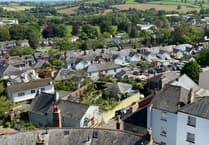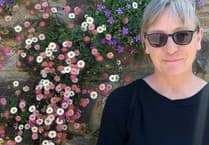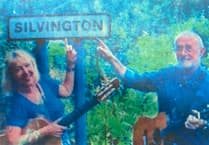A downed bomber, a hero pilot, a legendary commander and wartime tragedy all come together in a story of how the Second World War brutally arrived in the South Hams.
David Bolton, author, has been writing a biography of the last of the famous Dambusters, the RAF pilots and crew of Operation Chastise who used ‘bouncing bombs’ to destroy The Möhne and Edersee Dams in Germany in 1943.
In researching for his book, he came across a story of a plane that crashed at Woodleigh, a crash that, amazingly, three out of the four crew survived.
The following information has been provided for us by David Bolton.
Donald Joseph Curtin was born in New York in 1918. The son of a dentist, Don was a good pilot, but he took care not to be too good because the very best were retained as instructors back in Canada and that was the last thing Don Curtin wanted to be. He wanted to be part of the war.
He arrived in Britain at Bournemouth, and traveled to Spitalgate in Lincolnshire, at that time know as Bomber County owing to the huge number of hastily constructed bomber airfields that were scattered over the county, conveniently close to the North Sea coast and then Germany.
There Don Curtin learned to pilot a much heavier aircraft, the Airspeed Oxford, known affectionately by trainee pilots as the Oxbox.
On the night of his first operation, he piloted a Handley-Page Hampden in what Bomber Harris chose to dub a much-trumpeted Thousand Bomber Raid over Dusseldorf. In fact on that particular night Bomber Command only managed to muster a total of 630 bombers and this included many obsolete aircraft, of which the Hampden was one, and relatively untrained pilots.
Don Curtin was one of these. On that night he was still officially attached to an OTU (Operational Training Unit) with absolutely no experience of flying over enemy territory, at night, let alone dropping bombs on real targets. Much less did he have experience of being attacked by night fighters.
It should not be underestimated quite how clapped out this particular Hampden was. It had flown on dozens of sortie over Germany flying with 61 Squadron, been damaged by enemy ack ack (antiaircraft artillery) several times and finally pensioned off as a trainer for inexperienced pilots who doubtless subjected it to several heavy landings.
He might at this time have wondered what he had let himself in for or, to put it more crudely, what his chances were of surviving the war. In fact, fewer than one third of Bomber Command pilots lived to tell the tale after the war.
He took off from Cottesmore airfield in Rutland eight minutes after midnight on the night of August 1, 1942, with several other aircraft from Squadron 106. When nearing the target, the heavily defended industrial complex of Dusseldorf, Curtin’s aircraft was intercepted and attacked by a German night fighter.
Curtin threw his aircraft into a steep dive and thus managed to evade the fighter. He then flew on to the target and dropped his bombs. Shortly after leaving the target area, which was by this time criss-crossed by German searchlights, he was again intercepted by German fighters.
Their cannon fire scored several direct hits on the Hampden which resulted in Curtin’s rear gunner and wireless operator being badly injured. Curtin himself was almost blinded by cordite from a bursting shell and his aircraft plummeted out of control for several thousand feet.
Curtin, just in time, managed to clear his eyes, regain control and check his instruments. Later, on course back to Cotesmore, he crossed the Dutch coast and was again hit by anti-aircraft fire from guns on the Dutch coast.
This time Curtin’s navigator was wounded, leaving Curtin to attempt to find his own way back home. This proved to be extremely difficult - piloting a badly damaged aircraft and navigating at the same time was something of a hit and miss affair and unsurprisingly Curtin didn’t find his way back to Cottesmore.
Instead he flew down the English Channel and then over the south west coast of England, near Kingsbridge.
By this time he was running dangerously low on fuel and he therefore decided to crash land in a field near Wood Barton Farm, Woodleigh. Curtin just managed to drag his wounded crew out of their aircraft before it exploded.
He then went in search of help. In the words of the citation for his Distinguished Flying Cross, “Pilot Officer Curtin displayed great courage, determination and devotion to duty.” Few would argue with that.
Two members of his injured crew survived but his navigator was injured and his rear-gunner and wireless operator, Pilot Officer Harold Clarke, an Australian, was badly wounded by cannon shells from an incoming night fighter.
He died of his wounds just after midday in Kingsbridge Cottage Hospital. He was from Ivanhoe, Victoria, and his death is commemorated with a brass plaque on the wall of St Mary the Virgin in the Woodleigh. His gravestone is in the Commonwealth Higher Cemetery in Exeter.
Other members of the crew who survived were navigator Pilot Officer Stephen Walker and air gunner Sergeant Richard Hawkes. The fact that Curtin managed to get his aircraft and crew back to England at all was a minor miracle in itself.
14 Hampdens were shot down that night. All their crews were killed.
For his heroism, Don Curtin was awarded the DFC which was unique in as much as it was awarded to an American airman for the first time and also for the first time to an airman flying on his very first mission.
To call that operation a baptism of fire for Don Curtin would be a massive understatement.
From the ground the following eye-witness accounts have been recorded. Just before he died, Reg Sampson, a young local farmer from Loddiswell, wrote his autobiography. According to this, he wanted to enter the RAF but his job as farmer was deemed ’an essential occupation’ so he was disappointed.
Instead he joined the local Home Guard and wrote this account of his experiences: “Sergeant Lionel Ryder drilled the Loddiswell Platoon of the Home Guard into shape and I was soon selected to be the Right Marker when on parade, I suppose because I was tall and slight and I was getting into the habit of springing to attention at the right moment.
“The first parade however was a sad one. One of our Hampden bombers had been badly shot up returning over the channel. Fred Hine was at Torr Quarry at 7.30am when the distressed bomber circled overhead to use up fuel before landing.
“At the Shanty near Woodleigh, Jennifer Luscombe and her sister saw the plane come in very low past their window. Their father Roland Luscombe, who was a Special Constable, hurried off in his car to see where it had landed, followed by the girls on foot.
“The normal crew on a Hampden was five but there were only four on this plane. The plane was landed in a Court Barton cornfield, just behind the village of Woodleigh. It ploughed through the hedge into the second cornfield ripping off the undercarriage.
“The Navigator had been injured and the crew thought they were still in France in enemy territory. “The Rear Gunner had been severely machine gunned and was carried into the village on a stretcher. Jennifer held his hand as he was calling for his mother and this appeared to console him. He unfortunately died on his way to hospital.
“The second pilot kept his hand in his tunic pocket as his arm was broken and he also wanted to be taken in the ambulance. The Army Red Cross had by then arrived and said they would take care of him.
“Our Home Guard Platoon marched from Loddiswell to Woodleigh church to a Memorial Service for Harold Clarke of the Royal Australian Air Force, the rear gunner who had died.”
Ken Shute also remembers the crash. He was born in 1929 so was 13-years-old at the time. Although not living in Westleigh at the time, he worked on Wood Barton Farm all his life and so knew all about the events of that early morning.
“I’ve lived here in Woodleigh practically all my life and I know exactly where that plane crashed, about 400 yards from my home. It was in a field near the top of the hill, overlooking the Avon valley. The land’s owned by the Woodland Trust now and you can walk up there although there’s nothing to see, not after 75 years.”
After this baptism of fire, Curtin flew on no more operations with his Operational Training Unit but a month or so after his crash, on the September 6, 1942, he was posted to a Conversion Flight where he finally learned to fly a heavy bomber, the Lancaster.
Curtin subsequently flew on 26 operations over Germany flying with 106 Squadron based in Syerston, Nottinghamshire. The commander of that squadron was the legendary Guy Gibson, later to become famous for leading the Dambusters raid.
Don Curtin flew on several raids over the heavily defended Ruhr, dubbed Happy Valley by RAF bomber crews. In another daylight raid over Milan in October 1942 he was attacked by two Italian fighters. Curtin’s gunners managed to shoot down one attacking fighter and drive off the other one.
Subsequently Curtin, on two consecutive nights, took part in raids on Berlin, on the second night spending over 30 minutes over the target to ensure that his bombing was accurate. For this he was awarded a bar to his DFC, a fair reward for a rookie American who had only been flying on operations for three months.
Unfortunately Curtin’s luck ran out on the night of February 25, 1943, not much more than six months after he had flown his first mission. Piloting a Lancaster, W4886 based in Syerston he was shot down over the town of Furth. Curtin and all his crew were killed.
His body was buried on 2nd March 1943 and subsequently reinterred at Durnbeck War Cemetery. But his connection with South Devon is worth recording and remembering.




